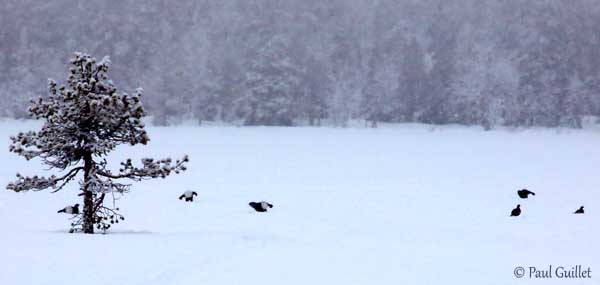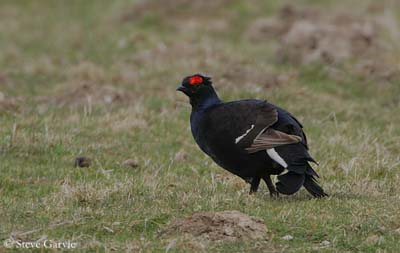
Black Grouse
Tetrao tetrix
Galliforme Order – Tetraonidae Family
BIOMETRICS:
Length : M : 60 cm – F : 45 cm
Weight : M : 1100-1250 g (sometimes up to 1800g)- F : 750-1100 g
LONGEVITY: Up to 12 years
DESCRIPTION:
Black Grouse (Male: Blackcock - Female: Greyhen) is a sedentary species which performs spectacular displays at lek. It is shy and wary.

Adult male has glossy black plumage with blue or green reflections. On the wings, we can see white carpal patch and conspicuous white wing bar. The undertail coverts used in displays are pure white.
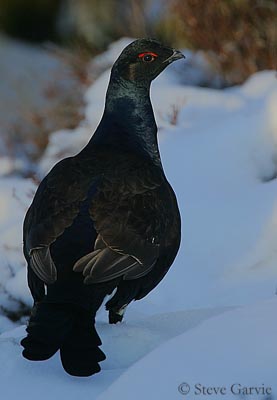
Tail presents lyre-shaped rectrices. The outer tail feathers are longer than central feathers and curved outwards.
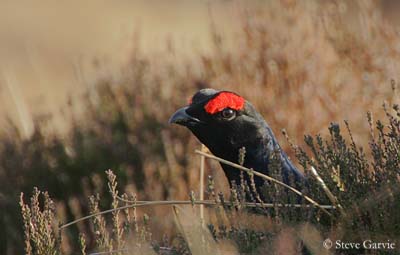
On the glossy black head, we can see bright red wattle above each eye.
The eyes are brown. The slightly down-curved bill is black.
Legs and feet are dark brown.
In post-breeding plumage, the male shows mottled or barred brown feathers on head and neck. Throat shows some white tinge and the red wattles are less distinct.
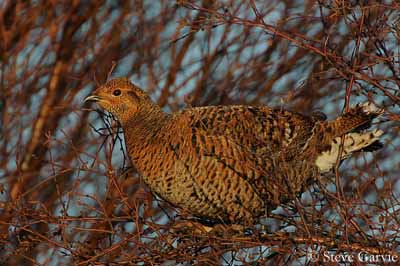
Female is smaller than male. She has brown cryptic plumage, heavily barred with black. We can see a narrow white wing bar. The tail is short and appears slightly forked when closed.
The first-winter resembles adults, but the young male is browner and duller. It reaches its sexual maturity at one year.
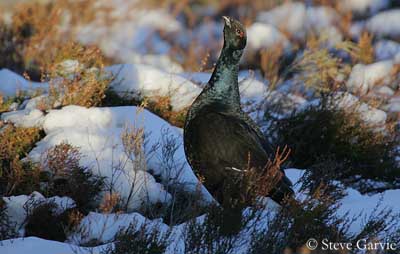
VOICE: SOUNDS BY XENO-CANTO
Black grouse is rather silent outside the lek. But during the displays, we can hear long, low bubbling croons, far-carrying sounds (until 3-4 km), given by displaying males. These croons are interspersed with harsh sneezed hiss “chooEESH”.
HABITAT:
Black Grouse often frequents the places between woodlands and open areas, such as steppes, marshes, heaths and cultivated areas at the edges.
But the habitat is very variable and we can found this species in lowlands and mountains up to 2000-3000 metres of elevation, mainly in coniferous forests but also in mixed woodlands. Usually, the breeding range includes a high variety of plants.
RANGE:
Black Grouse is sedentary and breeds across northern Eurasia, mostly in boreal regions. Some regular winter migrations are reported in parts of Siberia.
BEHAVIOUR:
Black Grouse feeds on plant-food, mainly in winter. During spring, it prefers berries, stems and shoot of several kinds of plants. Chicks feed on insects such as ants. Food depends of weather conditions.
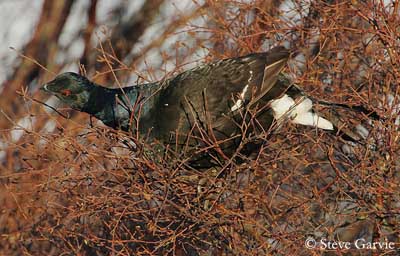
During breeding season, males perform courtship displays at leks or arenas. They gather to display at favoured sites at dawn. Such groups may gather up to 40 birds, but sometimes much more.
They perform this ritual almost all year round, except in late summer and in autumn, during the moulting period.
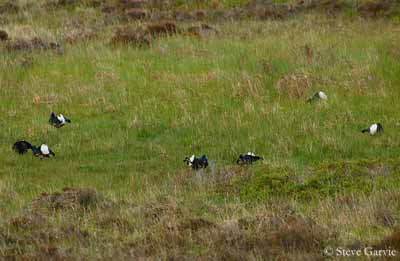
Leks or arenas are situated in clearings in the woods or at the edges of the forests. Males display to attract a female. Short time after arriving at the lek, males utter the typical “rookooing” call, while they cock and spread the tail in order to expose the white undertail coverts.
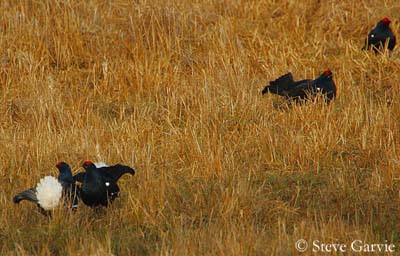
Usually, two males face up to each other and perform bowing duels, a kind of ritualized fighting (leading sometimes to a real fight).
While males fluff up the white feathers, they raise the lyre-shaped tail and inflate their blue necks, uttering a bubbling sound, a regular repeated dove-like cooing.
During these displays, females are watching nearby.
These displays may continue even without any female present. When a female is attracted by a male, copulation occurs. But male does not share the nesting duties.
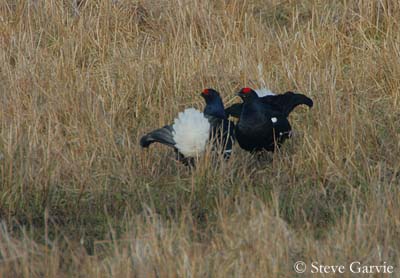
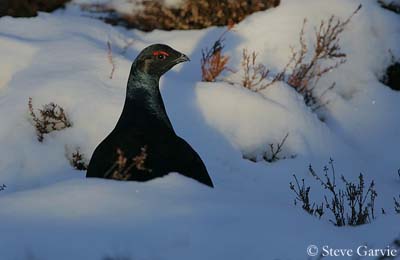
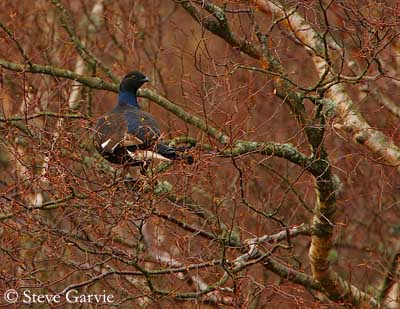
FLIGHT:
Black Grouse may flush with silent wing beats and easily perch in tree.
As other Galliforme species, it has relatively short, rounded wings, very useful for reaching great speeds quickly, but with high energy investment. The flight starts with a noisy take-off, then with a series of rapid wing beats interspersed with fast glides performed with down-curved wings.
REPRODUCTION:
Breeding season occurs in spring, with egg-laying in May-June.
Nest is on the ground, but it also may be situated low in bush. It is hidden among scrub or tall vegetation, between the roots at base of tree, under low vegetation or against a boulder.
It is a shallow depression scraped in the ground and lined with plants and feathers.
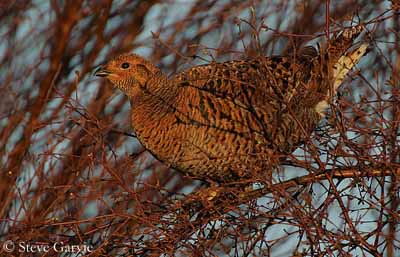
Female lays 6 to 11 creamy-white eggs with brown speckles. Incubation lasts about 25 to 27 days. Female leaves the nest three times a day for feeding.
Chicks leave the nest a few days after hatching, and they are able to fly between 15 days and one month of age. They feed on insects.
Female rears them alone.
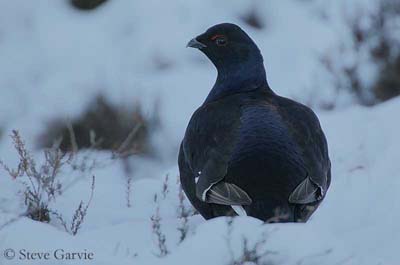
DIET:
Black Grouse feeds mainly on plant matter such as buds and shoots of several tree’s species and shrubs. They also consume berries and seeds. Chicks feed on insects such as ants.
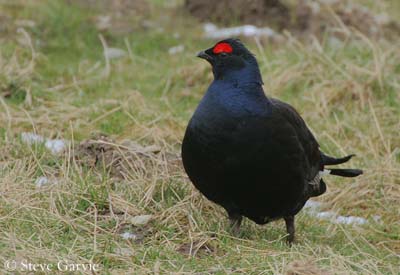
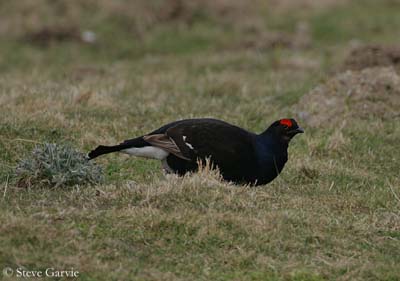
Fr: Tétras lyre
All : Birkhuhn
Esp : Gallo-lira común
Ital: Fagiano di monte
Nd: Korhoen
Photographers:
Steve Garvie
RAINBIRDER Photo galleries
Paul Guillet
Photos d’Oiseaux
Text by Nicole Bouglouan
Sources:
HANDBOOK OF THE BIRDS OF THE WORLD Vol 2 by Josep del Hoyo-Andrew Elliot-Jordi Sargatal - Lynx Edicions - ISBN: 8487334156
THE HANDBOOK OF BIRD IDENTIFICATION FOR EUROPE AND THE WESTERN PALEARCTIC by Mark Beaman, Steve Madge - C.Helm - ISBN: 0713639601
THE COMPLETE BOOK OF BRITISH BIRDS – Written by “Royal Society for the Protection of Birds” experts - Préface de Magnus Magnusson - Michael Cady- Rob Hume Editors - ISBN: 0749509112
Wikipedia (Wikipedia, The Free Encyclopedia)
The Longevity List (Roland Staav)
